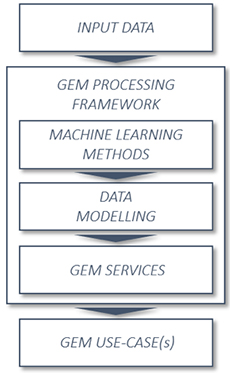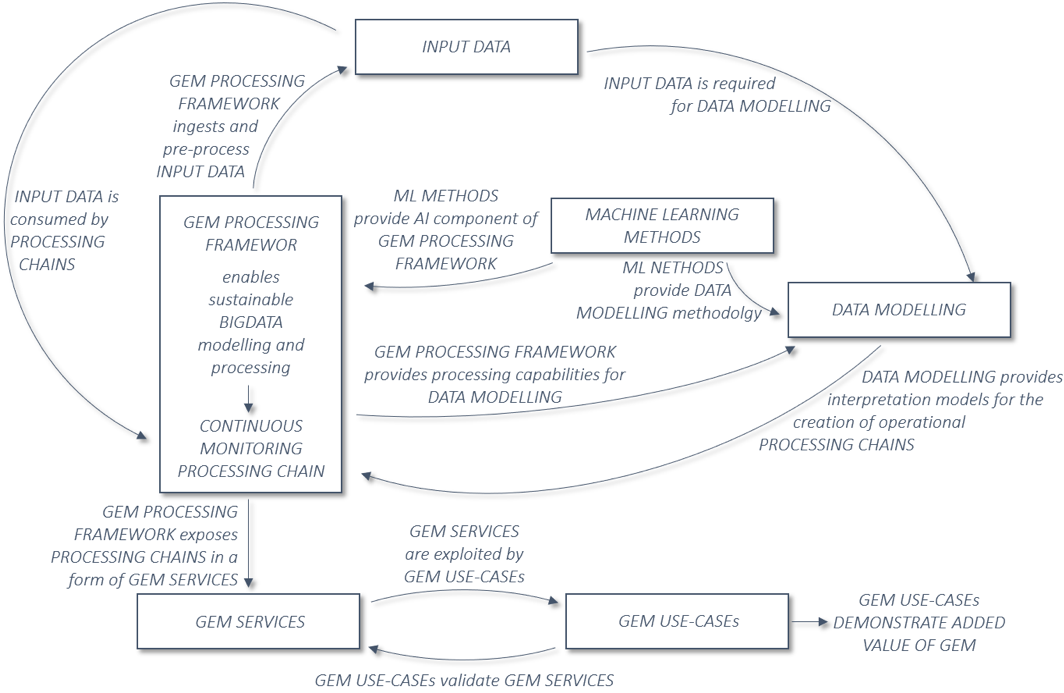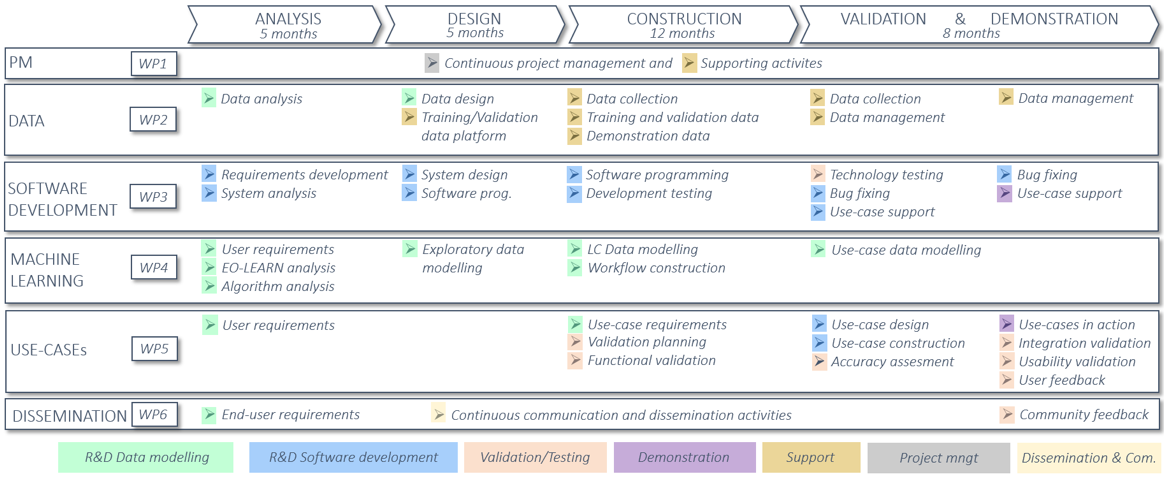Objective
To make full benefit of the volume of available data, Copernicus requires a new model of data exploitation – new processes, that can be run continuously – monthly, weekly, or even daily – replacing brute-force methods with smartly engineered techniques, which scale in a cost-efficient manner. New Earth Observation (EO) methods are required, which operate in a sustainable manner – producing more added value than their cost - on at least continental if not global scale, able to improve the accuracy automatically and detect changes as soon as they appear. Users of EO data need a way to pro-actively monitor the whole globe, automatically searching for changes and events that are worth investigating in more detail. The main objective of the Global Earth Monitor project (GEM) is to enable economically viable continuous monitoring of Earth, fuelled through the transition from conventional "strip mode" monitoring to "spot mode" monitoring (discovery of relevant details), the approach based on GEM’s global-monitoring data-exploitation model.
Global-Monitoring Data-Exploitation Model

GEM is addressing the challenge of continuous monitoring of large areas in a sustainable way. The new data-exploitation model, based on newly developed technology and newly designed methodology, will introduce a combination of periodical mapping (3-6 months) and instant change monitoring (5-30 days). The key to sustainable (cost-effective) exploitation will be introduced through a continuous change monitoring process:
- Cost optimised spotting (at low resolution, if possible) will be employed to detect areas of interest/change where
- a combination of medium/high-resolution data and super-resolution techniques will be used to drill into higher precision and interpret changes with the goal to
- update the maps automatically or alert the operators (map owners) at the same time providing them with all of the relevant information to verify the change.
Project’s Deliveries

The required deliveries of the project will address all levels of the processing chain, from data ingestion to exposure of value-added services:
NEW DATASETS
The current data capabilities of Sentinel Hub will be complemented with weather and climate data, VHR commercial EO data, Landsat-5 data, ground-truth datasets and statistical datasets.
GEM PROCESSING FRAMEWORK
Founded on existing Sentinel Hub and eo-learn services - new cloud-native capabilities to enable big-data processing/storage of data on global and regional scales, new types of processing chain integration to support transitions between sub-resolution, native resolution and super-resolution data models, all of it targeting cost efficient interpretation of data.
NEW MACHINE LEARNING (ML) METHODS
To serve GEM’s specific data modelling requirements (time-series modelling, causality modelling, sub-to-super resolution processing chains, etc.). Methods will be integrated into eo-learn, thus becoming freely available and reusable to wide user community, also outside GEM framework.
GLOBAL DATA INTERPRETATION MODEL
To facilitate global multi-purpose mapping and change monitoring. A specific global Land Cover interpretation model will be developed with the goals to use it as a part of GEM validation use-cases to employ it as the evaluation tool for the assessment and usability of newly integrated eo-learn’s ML methods.
GEM SERVICES
Mapping and Change Monitoring services will be exposed by Sentinel Hub to deliver GEM’s global monitoring capability = enabler of GEM’s Global-Monitoring Data-Exploitation Model.
GEM USE-CASES
Use-cases will be developed to demonstrate and validate the added value of GEM. 5 use-cases will be developed through the employment of GEM infrastructure: Land Cover Continuous Monitoring Service, Map making support, Conflict pre-warning map, Crop identification and Built-up area.
Concept
The GEM will approach challenges through parallel development of data, processing infrastructure, technology and methodology. It is important to note that all of the challenges are highly interdependent. The project’s concept reveals six tightly knitted technological and methodological elements with close relationships and clear dependence of each other.

- GEM will deliver services in all scales from global to micro.
- Data will be pre-processed to the level of Analysis Ready Data and transferred to Data Cube where it will be either permanently stored or created on-the-fly and later discarded.
- Data processing will be designed to support economically viable large-area (global and regional) continuous processing of big-data, reducing the amount of processing power and storage requirements through the usage of sub-resolution modelling.
- Services of higher spatial or/and temporal accuracy will be created on demand, typically involving creation of on-the-fly data cubes, native-resolution and super-resolution modelling and drill-down functionality, enabling smooth transition among different data scales (data resolutions).
- Two types of multi-purpose services will result from data modelling: Mapping services and Change Monitoring.
- GEM’s mapping and change monitoring services will be validated and demonstrated through their integration into GEM’s USE-CASEs.
Methodology
From the methodological perspective, a standardised approach to the execution of R&D projects is planned, early phases of the project dedicated to requirements definition, followed by several development cycles where methodological and technological concepts will be researched, then new solutions designed, prototyped and tested. The design and development activities will involve parallel and closely connected activities from all areas from data design, methodology development technology development and finally merging all of the development results into a prototype solution to enter the testing activities. Once the final prototype will be released, the project will reach its completion through validation and demonstration activities.

Seven different types of activities, distributed through four project Phases and 6 Work Packages are planned:

Work Packages
Six work packages (WPs) are planned - two WPs, Project management and support and Communication and dissemination are horizontal WPs, spanning through entire project, while the remaining four are dedicated into delivering tangible project results.

WP1: Project management and support coordinating project execution and providing support for all other parts of the project (quality assurance, project office, ICT infrastructure).
WP2: Data will take over the responsibility for data development, management, collection and data verification (data quality) and, providing inputs to all other WPs. Data quality is of paramount importance for the development of EO models since “garbage-in garbage-out” principles applies – the doubt about data quality must be eliminated in order to evaluate machine learning models.
WP3: Core platform will deliver main technological components of GEM: Main Data Interface, Adjustable Data Cube, Drill-down functionality and Front office capabilities as well as full integration with new eo-learn capabilities.
WP4: Machine learning will analyse existent ML Frameworks, upgrade eo-learn to interact with them, select and adapt ML algorithms to be fully integrated into eo-learn. The results of this work will be provided as an open source on GitHub, readily available for 3rd parties even outside of the GEM Platform.
WP5: Use-case development will provide integration validation of new GEM services, through the development of five use-case examples, demonstrating high integrability of newly developed front-office capabilities.
WP6: Dissemination communication and user engagement will promote/disseminate projects results and provide the required visibility to enable later smooth transition into the market.


